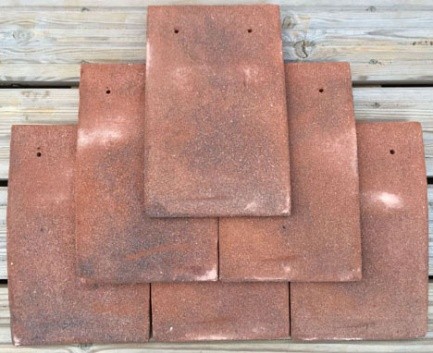Victorian Roof Tiles in Surrey
Heritage Tiles: Emblematic of the finest craftsmanship
Heritage tiles are the professional roofer's choice for the highest quality clay roof tiles. We pride ourselves in manufacturing, stocking, and delivering the very finest in prestige clay roof tiles.
Heritage Tiles have several tile ranges that satisfy every architectural requirement. Vintage and historic properties right up to modern new builds are covered by the diverse range of clay roof tiles that we stock.
So, whether you are in the building trade, or simply wish to choose your own tiles, Heritage Tiles have the right product for your specific requirements.
What Heritage Tiles have to offer our customers?
- We offer specification and technical solutions to help you achieve the perfect build.
- We also offer expert design advice to all our customers.
- We are happy to engage in site visits with our clients.
- We have stockists and distributors throughout the United Kingdom to ensure that we can provide our expert service to a wider area.
- We can provide estimated quantities from plans supplied by our clients.
- We offer battening plans.
- We can deliver a standard and bespoke colour choice for our clay tile products.
- All our tiles are assessed and approved by Lucideon.
- We provide a nationwide delivery and collection service.
The ranges of clay roof tiles we supply.
The Clayhall Range of roof tiles:

Clayhall Medium Blend - Carefully crafted to replicate all the features of handmade the Clayhall hand crafted range of tiles offers an excellent alternative when budget restrictions are a concern, but without compromising quality or durability.
Clayhall Dark Blend - Quality and durability in a budget clay roof tile. The Clayhall dark blend is sure to turn heads.
Clayhall Red Blend - A beautiful rustic clay roof tile. The Clayhall red blend is a firm favourite with our customers.
Clayhall Hamlet Mix - The Clayhall Hamlet mix is a gorgeous light and sandy looking clay roof tile that is a perennial favourite in the building trade.
Clayhall Birchwood Mix - The Clayhall Birchwood mix offers a gorgeous blend of lighter and darker shades in this diverse clay roof tile. If you are concerned that your roof tiles could look monotonous, the Clayhall Birchwood mix is the clay roof tile to choose.
The Conservation Range of roof tiles

The Conservation range of roof tiles are available in a range of distinctive colours, created by using a very fine sand, The Conservation Weathered; A natural warm tone, achieving an instant mellow and settled look and The Conservation Red; perfect for vertical tiling especially suited for villages and hamlets with olde world vernacular charm.
Manufactured using high quality clay, achieving high strength and durability properties, giving homeowners and contractors peace of mind for many years to come. The conservation range comes with a complete set of associated fittings, including Hog Back Ridge, Half Round Ridge, Bonnet Hips, Valley tiles and External Angles.
The Conservation range of clay roof tiles comes in the following variations:
- Conservation Red
- Conservation Weathered
- Conservation Dark
Conservation Peg Tile
Plain clay roofing tiles laid to a double lap have been used for roof covering in England since before the Norman Conquest and tiles dating back to Roman Times have been discovered under excavation. From the outset clay plain tiles were made incorporating fixing features.
The Classic Edwardian roof tile
The Classic range of plain tiles is one of the finest ranges of clay tiles.
We source only the best raw materials for our craftsman to create beautifully handmade clay tiles of the highest quality and durability.
Tile Fittings available from Heritage Tiles
There are many fittings that are available from us a Heritage Tiles to complete your build to perfection. We stock and supply the following:
- Gable Tile
- Eave Tile
- Baby Porch Ridge
- 90 Degree Ext. Angle
- Universal Bonnet Hip
- Half Round Ridge
- Hogs Back Ridge
- Mono Ridge
- Third Round Ridge
- Universal Valley
- Ornamental Club
- Bat Tile Set
Bat Tiles:
Provide help for our bats with our range of bat friendly roof tiles.
Did you know that all UK bats and their roosts are protected by law? The Wildlife and Countryside Act introduced in 1981, gave legal protection to all bat species and their roosts in England.
Distinct species of bats prefer differing places to roost. The two most usually found species of bat in the UK are the Pipistrelle and Brown Long-Eared Bat. Pipistrelle prefer confined spaces such as under tiles on roofs and hanging spaces. The Brown Long-Eared Bat prefer roof timbers and ridges inside lofts. Heritage Clay Tiles can provide purpose made access points within your roof tiles or ridge tiles. The Bat Tile Set can form part of a mitigation package required by law for existing roosts or as potential access where a roost had not previously been present.
Select a Blend
Getting the right blend for your roofing project can feel daunting, but with our blend generator you can mix and match various blends of tiles to achieve the perfect blend.
Click here to make use of our online tool to choose your own unique blend.
Because our strict quality control provides a consistent tile size you can mix assorted styles and colours of tiles to make your roof unique to you. Please use the tool below to experiment with various blends.
Adjust the sliders to set the ingredients for your desired blend then click on the update mix button.
Alternatively click on any blend or tile to display it.
Whatever type of clay roof tile you want, Heritage Tiles will be able to help.
Victorian Roof Tiles
Let's face it, roof tiles are designed primarily to keep out rain and heat, and are traditionally made from locally available materials such as clay. Some clay tiles have a waterproof glaze. With a large number of shapes and profiles of roof tiles have evolved over the years, but the traditional Victorian roof tile is a perrenial favourite not only in the United Kingdom, but around the globe. The Victorian era gave rise to many innovations and the architecture of this time was crowned with the durable and attractive Victorian roof tile.
As well as being a beautiful roof tile, rich in the history of tile making, our Victorian roof tile will able to keep out the very worst weather, ensuring your property never suffers from water leaking into the roof space. The quality and integrity of our Victorian roof tile is second to none.
Victorian roof tile: Quality without compromise
At Heritage Clay Tiles Ltd, we ensure that we only produce the very highest quality roof tiles and related roofing products. Our Victorian roof tile is no exception either. Adhering to traditional manufacturing methods, our customers are assured of a premium quality product at a fantastic price.
Even though the price of our Victorian roof tile is as low as we can make it, our customers will never have to compromise on the quality of the roof tiles they receive from us. Our customers expect the best from us and that is exactly what they will get with our Victorian roof tile.
Clay roofs have maintained their popularity mainly because of their aesthetic appeal and durability. Many clay roof tile manufacturers will offer a guarantee of thirty years, but experts believe that clay tiles should last for a minimum period of sixty years. As most people are aware, there are many roofs covered in clay roof tiles that have well exceeded one hundred years without any issues. The lifespan of clay roof tiles can be extended depending on where you live and how well maintained they are.
If the roof tiles are exposed to sustained periods of very severe weather, there are likely to require repairs at some stage. In areas where the weather is less of an issue, clay roof tiles will be able to withstand typical weather seasons without any problems.
Here at Heritage Clay Tiles Ltd we appreciate that the weather is something beyond our control and severe weather conditions will always test the durability of clay roof tiles over a protracted period of time. This is why we supply all our clay roof tiles to be robust and stand the test of time and our handmade Victorian roof tiles are no different.
Although bad weather can give roof tiles a bad time, the Victorian roof tile from Heritage Clay Tiles Ltd actually look better once they have weathered and aged a little. They just seem to blend into the property even better by taking on the mosses and lichens that give roofs a pleasing aged look.
Our professional sales team are able to advise you on the Victorian roof tile we carefully hand produce and any other roofing product from our vast range. Why not look at the select a blend section on our website and mix some other clay tiles into a blend to make the Victorian roof tile you lay look even more stunning?
A little information about Surrey
The move from military might to social standing
By the 14th century, castles were of dwindling military importance, but remained a mark of social prestige, leading to the construction of castles at Starborough near Lingfield by Lord Cobham, and at Betchworth by John Fitzalan, whose father had recently inherited the Earldom of Surrey. Though Reigate and Bletchingley remained modest settlements, the role of their castles as local centres for the two leading aristocratic interests in Surrey had enabled them to gain borough status by the early 13th century. As a result, they gained representation in Parliament when it became established towards the end of that century, alongside the more substantial urban settlements of Guildford and Southwark. Surreys third large town, Kingston, despite its size, borough status and historical association with the monarchy, did not gain parliamentary representation until 1832.
Surrey had little political or economic significance in the Middle Ages. Its agricultural wealth was limited by the infertility of most of its soils, and it was not the main power base of any important aristocratic family, nor the seat of a bishopric. The London suburb of Southwark was a major urban settlement, and the proximity of the capital boosted the wealth and population of the surrounding area, but urban development elsewhere was sapped by the overshadowing predominance of London and by the lack of direct access to the sea. Population pressure in the 12th and 13th centuries initiated the gradual clearing of the Weald, the forest spanning the borders of Surrey, Sussex and Kent, which had been left undeveloped due to the difficulty of farming on its heavy clay soil.
The Surrey cloth industry
Surrey had a most significant source of prosperity in the later Middle Ages was the production of woollen cloth, which emerged during that period as Englands main export industry. The county was an early centre of English textile manufacturing, benefiting from the presence of deposits of fullers earth, the rare mineral composite important in the process of finishing cloth, around Reigate and Nutfield. The industry in Surrey was focused on Guildford, which gave its name to a variety of cloth, gilforte, which was exported widely across Europe and the Middle East and imitated by manufacturers elsewhere in Europe. However, as the English cloth industry expanded, Surrey was outstripped by other growing regions of production.
Though Surrey was not the scene of serious fighting in the various rebellions and civil wars of the period, armies from Kent heading for London via Southwark passed through what were then the extreme north eastern fringes of Surrey during the Peasants Revolt of 1381 and Cades Rebellion in 1450, and at various stages of the Wars of the Roses in 1460, 1469 and 1471. The upheaval of 1381 also involved widespread local unrest in Surrey, as was the case all across south eastern England, and some recruits from Surrey joined the Kentish rebel army.
Christianity in Surrey
In 1082 a Cluniac abbey was founded at Bermondsey by Alwine, a wealthy English citizen of London. Waverley Abbey near Farnham, founded in 1128, was the first Cistercian monastery in England. Over the next quarter of a century monks spread out from here to found new houses, creating a network of twelve monasteries descended from Waverley across southern and central England. The 12th and early 13th centuries also saw the establishment of Augustinian priories at Merton, Newark, Tandridge, Southwark and Reigate. A Dominican friary was established at Guildford by Henry IIIs widow Eleanor of Provence, in memory of her grandson who had died at Guildford in 1274. In the 15th century a Carthusian priory was founded by King Henry V at Sheen. These would all perish, along with the important Benedictine abbey of Chertsey, in the 16th century Dissolution of the Monasteries.
Products available from Heritage Clay Tiles Ltd in East Sussex
Clay Roof Tiles in East Sussex
Clayhall Roof Tiles in East Sussex
Conservation Roof Tiles in East Sussex
Edwardian Roof Tiles in East Sussex
Victorian Roof Tiles in East Sussex
Georgian Roof Tiles in East Sussex
Handmade Clay Tiles in East Sussex
Handmade Roof Tiles in East Sussex
High Quality Roof Tiles in East Sussex
Traditional clay tiles in East Sussex
Traditional roof tiles in East Sussex
Products available from Heritage Clay Tiles Ltd in Essex
Conservation Roof Tiles in Essex
High Quality Roof Tiles in Essex
Traditional clay tiles in Essex
Traditional roof tiles in Essex
Products available from Heritage Clay Tiles Ltd in Hampshire
Clayhall Roof Tiles in Hampshire
Conservation Roof Tiles in Hampshire
Edwardian Roof Tiles in Hampshire
Victorian Roof Tiles in Hampshire
Georgian Roof Tiles in Hampshire
Handmade Clay Tiles in Hampshire
Handmade Roof Tiles in Hampshire
High Quality Roof Tiles in Hampshire
Traditional clay tiles in Hampshire
Traditional roof tiles in Hampshire
Products available from Heritage Clay Tiles Ltd in Hertfordshire
Clay Roof Tiles in Hertfordshire
Clayhall Roof Tiles in Hertfordshire
Conservation Roof Tiles in Hertfordshire
Edwardian Roof Tiles in Hertfordshire
Victorian Roof Tiles in Hertfordshire
Georgian Roof Tiles in Hertfordshire
Handmade Clay Tiles in Hertfordshire
Handmade Roof Tiles in Hertfordshire
High Quality Roof Tiles in Hertfordshire
Traditional clay tiles in Hertfordshire
Traditional roof tiles in Hertfordshire
Products available from Heritage Clay Tiles Ltd in Kent
Conservation Roof Tiles in Kent
High Quality Roof Tiles in Kent
Traditional clay tiles in Kent
Traditional roof tiles in Kent
Products available from Heritage Clay Tiles Ltd in London
Conservation Roof Tiles in London
Edwardian Roof Tiles in London
Victorian Roof Tiles in London
High Quality Roof Tiles in London
Traditional clay tiles in London
Traditional roof tiles in London
Products available from Heritage Clay Tiles Ltd in Surrey
Conservation Roof Tiles in Surrey
Edwardian Roof Tiles in Surrey
High Quality Roof Tiles in Surrey
Traditional clay tiles in Surrey
Traditional roof tiles in Surrey
Products available from Heritage Clay Tiles Ltd in West Sussex
Clay Roof Tiles in West Sussex
Clayhall Roof Tiles in West Sussex
Conservation Roof Tiles in West Sussex
Edwardian Roof Tiles in West Sussex
Victorian Roof Tiles in West Sussex
Georgian Roof Tiles in West Sussex
Handmade Clay Tiles in West Sussex
Handmade Roof Tiles in West Sussex
High Quality Roof Tiles in West Sussex
Traditional clay tiles in West Sussex
Traditional roof tiles in West Sussex
Products available from Heritage Clay Tiles Ltd in Bedfordshire
Clay Roof Tiles in Bedfordshire
Clayhall Roof Tiles in Bedfordshire
Conservation Roof Tiles in Bedfordshire
Edwardian Roof Tiles in Bedfordshire
Victorian Roof Tiles in Bedfordshire
Georgian Roof Tiles in Bedfordshire
Handmade Clay Tiles in Bedfordshire
Handmade Roof Tiles in Bedfordshire
High Quality Roof Tiles in Bedfordshire
Traditional clay tiles in Bedfordshire
Traditional roof tiles in Bedfordshire
Products available from Heritage Clay Tiles Ltd in Berkshire
Clayhall Roof Tiles in Berkshire
Conservation Roof Tiles in Berkshire
Edwardian Roof Tiles in Berkshire
Victorian Roof Tiles in Berkshire
Georgian Roof Tiles in Berkshire
Handmade Clay Tiles in Berkshire
Handmade Roof Tiles in Berkshire
High Quality Roof Tiles in Berkshire
Traditional clay tiles in Berkshire
Traditional roof tiles in Berkshire
Products available from Heritage Clay Tiles Ltd in Buckinghamshire
Clay Roof Tiles in Buckinghamshire
Clayhall Roof Tiles in Buckinghamshire
Conservation Roof Tiles in Buckinghamshire
Edwardian Roof Tiles in Buckinghamshire
Victorian Roof Tiles in Buckinghamshire
Georgian Roof Tiles in Buckinghamshire
Handmade Clay Tiles in Buckinghamshire
Handmade Roof Tiles in Buckinghamshire
High Quality Roof Tiles in Buckinghamshire
Traditional clay tiles in Buckinghamshire
Traditional roof tiles in Buckinghamshire
Products available from Heritage Clay Tiles Ltd in Cambridgeshire
Clay Roof Tiles in Cambridgeshire
Clayhall Roof Tiles in Cambridgeshire
Conservation Roof Tiles in Cambridgeshire
Edwardian Roof Tiles in Cambridgeshire
Victorian Roof Tiles in Cambridgeshire
Georgian Roof Tiles in Cambridgeshire
Handmade Clay Tiles in Cambridgeshire
Handmade Roof Tiles in Cambridgeshire
High Quality Roof Tiles in Cambridgeshire
Traditional clay tiles in Cambridgeshire
Traditional roof tiles in Cambridgeshire
Products available from Heritage Clay Tiles Ltd in Oxfordshire
Clay Roof Tiles in Oxfordshire
Clayhall Roof Tiles in Oxfordshire
Conservation Roof Tiles in Oxfordshire
Edwardian Roof Tiles in Oxfordshire
Victorian Roof Tiles in Oxfordshire
Georgian Roof Tiles in Oxfordshire
Handmade Clay Tiles in Oxfordshire
Handmade Roof Tiles in Oxfordshire
High Quality Roof Tiles in Oxfordshire
Traditional clay tiles in Oxfordshire
Traditional roof tiles in Oxfordshire
Products available from Heritage Clay Tiles Ltd in Suffolk
Clayhall Roof Tiles in Suffolk
Conservation Roof Tiles in Suffolk
Edwardian Roof Tiles in Suffolk
Victorian Roof Tiles in Suffolk
Georgian Roof Tiles in Suffolk
Handmade Clay Tiles in Suffolk
Handmade Roof Tiles in Suffolk
High Quality Roof Tiles in Suffolk
Traditional clay tiles in Suffolk
Traditional roof tiles in Suffolk
Further Information
If you would like to know more or are interested in a quote we would be happy to help. Phone us on 01634 471 344, email us at sales@heritagetiles.co.uk and we will be in touch as soon as possible.







